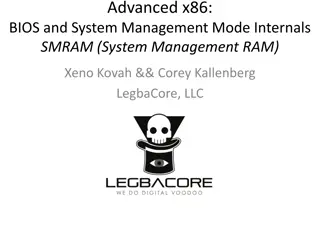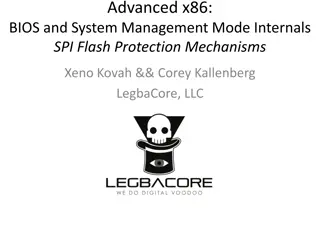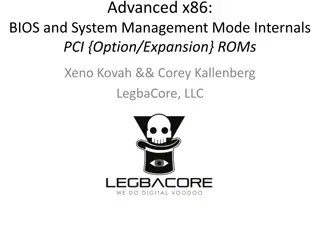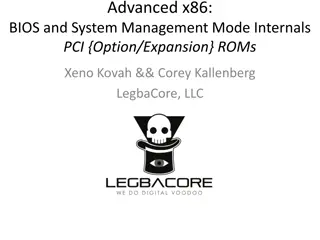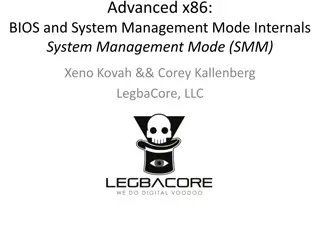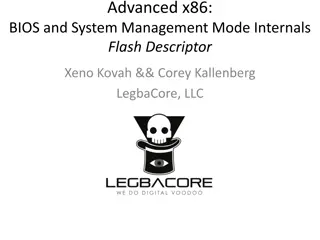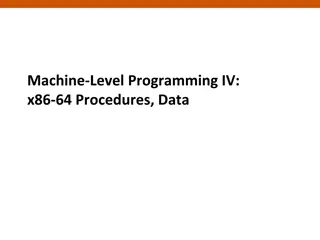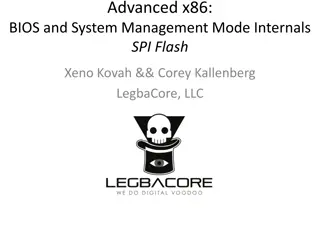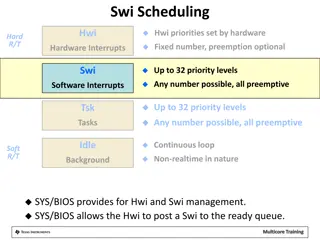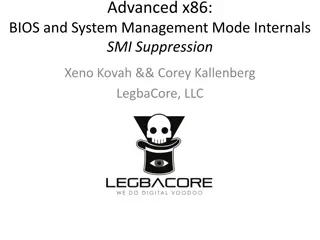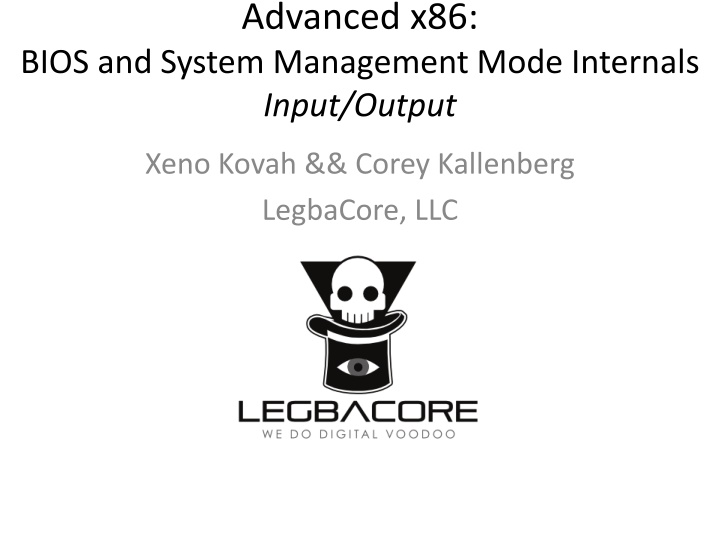
Advanced x86 BIOS and System Management Mode Internals
Explore the intricacies of Input/Output (I/O) operations in x86 systems, including Memory-Mapped I/O and Port I/O. Learn about accessing peripheral devices, addressing space, and the role of I/O Controller Hub.
Download Presentation

Please find below an Image/Link to download the presentation.
The content on the website is provided AS IS for your information and personal use only. It may not be sold, licensed, or shared on other websites without obtaining consent from the author. If you encounter any issues during the download, it is possible that the publisher has removed the file from their server.
You are allowed to download the files provided on this website for personal or commercial use, subject to the condition that they are used lawfully. All files are the property of their respective owners.
The content on the website is provided AS IS for your information and personal use only. It may not be sold, licensed, or shared on other websites without obtaining consent from the author.
E N D
Presentation Transcript
Advanced x86: BIOS and System Management Mode Internals Input/Output Xeno Kovah && Corey Kallenberg LegbaCore, LLC
All materials are licensed under a Creative Commons Share Alike license. http://creativecommons.org/licenses/by-sa/3.0/ Attribution condition: You must indicate that derivative work "Is derived from John Butterworth & Xeno Kovah s Advanced Intel x86: BIOS and SMM class posted at http://opensecuritytraining.info/IntroBIOS.html 2
Input/Output (I/O) I/O, I/O, it s off to work we go
2 Types of I/O 1. 2. Memory-Mapped I/O (MMIO) Port I/O (PIO) Also called Isolated I/O or port-mapped IO (PMIO) X86 systems employ both-types of I/O Both methods map peripheral devices Address space of each is accessed using instructions typically requires Ring 0 privileges Real-Addressing mode has no implementation of rings, so no privilege escalation needed I/O ports can be mapped so that they appear in the I/O address space or the physical-memory address space (memory mapped I/O) or both Example: PCI configuration space in a PCIe system both memory-mapped and accessible via port I/O. We ll learn about that in the next section The I/O Controller Hub contains the registers that are located in both the I/O Address Space and the Memory-Mapped address space 4
Memory-Mapped I/O Devices can also be mapped to the physical address space instead of (or in addition to) the I/O address space Even though it is a hardware device on the other end of that access request, you can operate on it like it's memory: Any of the processor s instructions that reference memory can be used to access an I/O port located at a physical-memory address (MOV, for example) Operations like AND, OR, and TEST can be used on data at a memory-mapped address Access byte, word, dword The MOV instruction itself requires privileges only in protected mode based on the privilege level of the descriptor describing the segment 5
Memory-Mapped I/O For people not accustomed to working in low-level space, the term memory mapping can be a little confusing, mainly because of how the term is often used, for example: Device X is mapped to memory. People sometimes get confused by this phrasing: Are it s contents copied to RAM? Or are memory accesses destined for that memory range redirected (decoded) to the device? It s the second one. Accesses destined to that memory range are decoded to the device 6
Memory Mapped IO The colored regions are memory mapped devices Accesses to these memory ranges are decoded to a device itself Flash refers to the BIOS flash APIC is the Advanced Programmable Interrupt Controller PCI Memory range is programmed by BIOS in the PCIEXBAR 7
Peripherals that Map to Both Devices can map to both memory and IO address space PCI Express is a good example of devices that map to both the IO address space and the physical memory address space Compatible PCI configuration space maps to IO Addresses CF8h and CFCh Both Compatible PCI configuration space plus the extended header are also mapped to a memory location/size defined by the PCIEXBAR register located in the DRAM Controller We'll get into this again once we get to PCI 8
Port I/O Address Space Software and hardware architectures of x86 architecture support a separate address space called I/O Address Space Separate from memory space Access to this separate I/O space is handled through a set of I/O instructions IN,OUT, INS, OUTS Access requires Ring0 privileges Access requirement does not apply to all operating modes (like Real-Mode) The processor allows 64 KB+3 bytes to be addressed within the I/O space Harkens back to a time when memory was not so plentiful You may never see port I/O when analyzing high-level applications, but in systems programming (and especially BIOS) you will see lots of port I/O One of the biggest impediments to understanding what's going on in a BIOS Port 65535 0xFFFF . . . I/O Address Space . . . Port 4 0x0004 Port 3 0x0003 Port 2 0x0002 Port 1 0x0001 Port 0 0x0000 Intel Programmer s guide, Vol 1, 16.1 9
Port I/O Accesses Port I/O access are handled by the Controller Hub (ICH/PCH) So in a chipset that has a Memory Controller Hub (MCH), the MCH performs no translation of accesses to I/O space The MCH just forwards them to DMI (and thus to the I/O Controller Hub) The Controller Hub contains the registers that are located in the I/O address space Again, separate and distinct from physical memory address space 0xFFFF I/O Space 0x0000 Intel Programmer s guide, Vol 1, 16.1 10
How does the hardware distinguish between port IO and memory access? Intel 8088 chip (from the bad old days) There's a pin for that! http://www.cpu- world.com/info/Pi nouts/8088.html 11
I/O Mapped Address Space I/O Address space consists of two ranges or types of access: 1. Fixed Addresses/peripherals cannot be relocated In some instances they can be disabled, but not all Variable These addresses can be relocated Can also be disabled Addressable size can be 8 bits, 16 bits, or 32 bits 2. 12
1. Fixed I/O Ports The addresses depend on the implementation of the I/O Controller Hub present in your system Check the I/O Controller Hub Datasheet to make sure you are interpreting these signals properly Address ranges that are not listed or marked Reserved are not decoded by the ICH Unless one of the variable ranges has been relocated to that address Each fixed IO address is a 2-byte word Remember, on the other side of each port address/range there is a hardware device Device interaction and behavior will differ between devices This is why it can be difficult to decipher when analyzing Port I/O is a gateway to a black box Intel, Vol 1, 16.1 13
Port 60 is the historic location of the 8042 keyboard controller status/command port. And port 64 is the data port. Notice how it doesn't tell you that, it just says they're being forwarded on to LCP. Annoying for trying to figure out what's being talked to 15
This one well talk about explicitly later in the context of SMM Takeaway: there s a lot of fixed IO address space, and it s fragmented too. This is why it s recommended that devices map their interfaces to memory rather than IO address space 16
2. Variable I/O Ports Can be relocated to another address Can be set/disabled using Base Address Registers (BARs) or configuration bits in the various PCI configuration spaces Which we shall discuss very soon! The BIOS (and/or other PCI devices or ACPI) can adjust these values Actually pretty much any privileged app can The same as the fixed range, on the other side of each port address/range there is a peripheral device Device interaction and behavior will differ between devices ICH does not check for overlap Results unpredictable if overlapping Has been used for virtualization attacks Intel, Vol 1, 16.1 17
IN - Input from Port Note it's DX, not DL. That means the DX form can specify all 2^16 ports, but the IMM8 form can only specify 2^8 ports. When accessing a 16- and 32-bit I/O port, the operand-size attribute determines the port size. (Because as usual there's an overloaded opcode for 16/32 bit form) Remember if you're in a 16 bit segment it's 16 bit, if you're in a 32 bit segment it's 32 bit. But you can override it with an operand size instruction prefix which is talked about later. From Xeno Kovah s Intermediate X86 class: http://OpenSecurityTraining.info/IntermediateX86.html 19
OUT - Output to Port Basically the same caveat as IN From Xeno Kovah s Intermediate X86 class: http://OpenSecurityTraining.info/IntermediateX86.html 20
IO Privilege Level There are two bits in the *FLAGS register which the OS will typically set to 0, which indicate that only ring 0 is allowed to issue the IN/OUT instructions 21
= Intro x86-64 = Intermediate x86-64 I O P L O F D F A F P F C F I D R F I F T F S F Z F Intel Vol 1 Sec 3.4.3.1 - page 3-21 - May 2012 manuals
Port IO Assembly Examples (showing that you can either use an 8 bit immediate or a 16 bit register (dx) to specify port and 8 bit immediate or 8/16/32 bit registers (but only AL/AX/EAX) to specify the data being read/written) Read from port 0xB3: IN AL, 0xB3 MOV AX, 0x1234 MOV DX, 0xB2 OUT DX, AX Write 0x1234 to port 0xB2: MOV AX, 0x1234 OUT 0xB2, AX Index/Data pair read offset 0x05: MOV DX, 0x70 OUT DX, 0x05 MOV DX, 0x71 IN EAX, DX MOV AL, 0x05 MOV DX, 0x70 OUT DX, AL MOV DX, 0x71 IN EAX, DX Index/Data pair write to offset 0x05: MOV AL, 0x05 MOV DX, 0x70 OUT DX, AL MOV DX, 0x71 MOV EAX, 0x10 OUT DX, EAX 23
Port IO MOV DX, PORT OUT DX, IMM8 CPU Black Box MOV DX, PORT IN AX, DX Black Box CPU IMM8 (one byte constant) could be a command or data that s up to the interpretation by the device It is not necessarily known what the black box on the end of a port does Check your Controller Hub datasheet and/or the LPC decode registers (might offer clues) 24
Port IO Index/Data Pair Black Box MOV DX, 0x70 OUT DX, IMM8 MOV DX, 0x71 OUT DX, IMM8 CPU Some devices use an index/data pair for IO An offset is written to the index port Next a value is read from or written to that offset from the Data port Devices such as this are CMOS, PCI, and the Keyboard Embedded Controller on the E6400 (per the below research) http://esec-lab.sogeti.com/dotclear/public/publications/11-recon- stickyfingers_slides.pdf 25
Identifying Port I/O First try deciphering port IO devices by using the datasheets (Controller Hub either ICH or PCH) OS Dev http://wiki.osdev.org/I/O_Ports (which links you to...) Boch sor Ralf s http://bochs.sourceforge.net/techspec/PORTS.LST Last change was in 11/6/94 and that s just how it is with most BIOS information Vendors can extend a device interface to any unoccupied IO address 26
UEFI indirection When we eventually get to UEFI you will see that there s a lot of indirection. So this is just to say that if you were REing some code, while you might eventually find the actual IN/OUT instructions, it would suffice to find EFI_CPU_IO2_PROTOCOL.Io.Read() and Io.Write() which are functionally equivalent You can read more about them in the UEFI specs Volume 5 27
Example: Port IO Configuring PCIEXBAR Chipset DRAM Controller B0:D0:F0 Offset Name Value 60h PCIEXBAR F8000001h F800_0000h On the Mobile 4-Series Chipset, the BIOS (executed by the CPU), configures the PCIEXBAR in the DRAM Controller F800_0000h (on an E6400 with 4GB RAM for example) PCI Memory range is now mapped So how does this configuration actually occur? PCI 28






